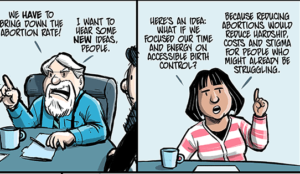
Source: Black Is Online
Originally published on Alternet and cross-posted here with their permission.
Feminism is much more than simply addressing the wage gap, climbing the corporate ladder, or even ensuring access to abortion services.
Many times racism, classism and sexism are so tightly enmeshed they’re impossible to untangle, and therefore feel like one brutal and engulfing entity. Women of color have never had the privilege to solely focus on women’s issues—gender and racial inequalities combined so often ravage both our physical and mental health.
In order to advance our gender as a whole, it’s critical for all women to acknowledge and support each others’ diverse struggles and experiences.
Here are four ways women of color experience sexism differently.
1. Higher Wage Gap and Rates of Poverty
Though we all know that American women are paid only 77 cents for every dollar a man earns, many don’t realize that the wage gap is even larger for women of color.
According to the National Women’s Law Center, African-American women make only 62 cents, and Hispanic women only 54 cents, for every dollar earned by white, non-Hispanic men. Every year, this loss translates to $19,575 for African-American women and $23,873 for Hispanic women.
These numbers are staggering.
In 2012, Adriana Kugler, former chief economist to Labor Secretary Solís, pointed out that, “Due to the wage gap, the average lifetime loss in salary for an American woman is $400,000, but for a Latina, the number goes up to $800,000.”
This critical loss of income can make it difficult for women to care for their families, and as a result, perpetuate the cycle of poverty. Currently, 35 percent of African Americans, and 33 percent of Hispanics live in poverty, compared to 13 percent of whites.
Part of what contributes to the high levels of poverty are the disproportionate unemployment rates. According to a 2013 report from Center for American Progress, African-American women had an unemployment rate of 10.5 percent, compared to 5.8 percent for white women.
Because of the wage gap and high unemployment rates, it’s incredibly difficult for these women to accumulate wealth, particularly when they are single. Married or cohabiting African-American households have a median wealth of $31,500, but single African-American women have a median wealth of only $100. African-American women with children have zero median wealth.
These numbers are unlikely to improve any time soon due to our weak economy, lack of wage gap legislation and consistent attacks on Affirmative Action.
Last month, Senate Republicans unanimously voted against advancing the Paycheck Fairness Act, and just last week, the U.S. Supreme Court on Tuesday further eroded Affirmative Action by upholding a voter-approved Michigan law that banned the practice of racial preferences in admissions decisions in state universities. This can lead to other states following suit.
If these rights—originally designed to level the playing field—are taken from us, it’s highly unlikely that companies will be hiring women of color and paying them a fair wage out the goodness of their hearts or strong commitment to diversity.
2. Higher Health Disparities
It’s no surprise that women of color fare much worse when it comes to health.
According to the Center for Reproductive Rights, African-American women die in pregnancy or childbirth at a rate of three to four times the rate of white women. What’s even more shocking is that these rates have not changed for 50 years.
And when it comes to STIs, nearly all minority groups have much higher rates than the majority white population. African-American women and Latinas combined, for instance, account for 80 percent of reported female HIV/AIDS diagnoses, even though they represent only 25 percent of the U.S. female population.
Latinas and African-American women in the United States also have the highest rates of cervical cancer and are most likely to die than any other group.
These health imbalances extend beyond reproductive health. According to the Centers for Disease Control, more than 80 percent of African-American and 70 percent of Hispanic women are overweight or obese, compared to just 50 percent of white women.
African Americans, Hispanic/Latino Americans, American Indians, Asian Americans, and Pacific Islander Americans are at particularly high risk for type 2 diabetes, and gestational diabetes occurs more frequently in African Americans, Hispanic/Latino Americans, and American Indians than in other groups.
Poverty, lack of access to healthcare, cultural attitudes and behaviors are some of the barriers facing many minority women in accessing preventive care and diabetes management.
Luckily, the Affordable Care Act can help bridge some of these health disparities for women of color. Under the act, women cannot be denied coverage or charged more because of their gender, and they have access to preventive services with no out-of-pocket costs.
Health plans must also cover maternity services. In 2012, 36 percent of Latinas were uninsured, which is the highest of any racial group, but through the Marketplace, many will now have new opportunities for affordable health insurance coverage.
3. Racially Charged, Sexist Stereotypes in the Workplace
Thanks to the many misconceptions proliferated by the media, women of color are often prone to discrimination that white women may never have to confront in their everyday lives or in the workplace.
The angry/sassy black woman stereotype, for instance, can affect the ways in which women are perceived by not only their employers, but the rest of the world.
The same goes for the spicy and fiery Latina trope. Assertiveness can often be misinterpreted as aggression or anger. Our reactions to situations are often chalked up to our “hot tempers,” and as a result, are completely dismissed. Many are afraid to express their feelings for fear of being labeled “too emotional.”
Though it’s against the law to racially discriminate against employees or applicants, it’s undeniable that these kinds of misconceptions affect the ways women are treated in the workplace. It’s no surprise, for instance, that white men are three times as likely to get management jobs as equally qualified black women.
4. Our Bodies Are Perceived as Dangerous
While all women’s bodies are perpetually susceptible to scrutiny, women of color are particularly vulnerable to the dehumanizing male gaze, and often depicted as both hyper-sexual and hyper-fertile. Stereotypes abound for black women—jezebels, welfare queens and video vixens.
The notion of blackness as sexually deviant traces its roots back to slavery. Latina bodies are often perceived as a threat due to their “uncontrollable fertility,” and are blamed for overpopulation. The derogatory term “anchor baby,” for instance, refers to U.S-born children of undocumented immigrants used to “anchor” the parents in the country.
Because women of color are perceived as undesirables, their bodies have been vulnerable to inhumane practices, such as coerced sterilization. While abortion is often at the forefront of reproductive rights conversations and debates, forced sterilization is often overlooked and forgotten.
From 1929 until 1974, an estimated 7,600 people considered mentally deficient by public health officials were sterilized under North Carolina’s eugenics program. Though this practice may seem like a dark time from our past, the Center for Investigative Reporting found that doctors under contract with the California Department of Corrections and Rehabilitation sterilized nearly 150 female inmates from 2006 to 2010 without required state approvals.
African-American and Latina women made up 59 percent of the California prison population in 2010.
[do_widget id=”text-101″]
Want to discuss this further? Visit our online forum and start a post!
Erika L. Sánchez is a poet, writer and editor living in Chicago. She is the sex and love advice columnist for Cosmopolitan for Latinas and has contributed to the Guardian, NBC News, Rolling Stone, Al Jazeera, Truthout, Salon, and many other publications.
Search our 3000+ articles!
Read our articles about:
Our online racial justice training
Used by hundreds of universities, non-profits, and businesses.
Click to learn more
Most Read Articles
- « Previous
- 1
- …
- 30
- 31
- 32



















